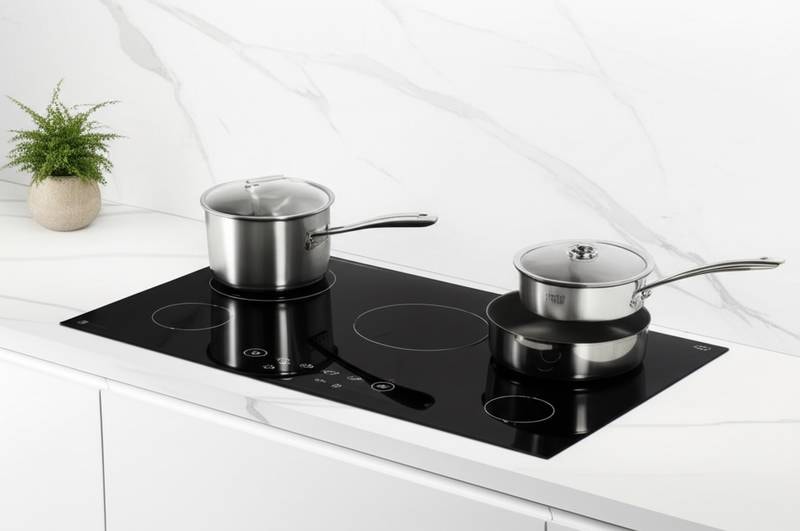The Shift to Induction in 2025 Kitchens
Kitchens evolve with societal priorities, transitioning from traditional hearths to efficient, design-forward environments. Gas cooktops long represented culinary prowess through their visible flames, yet induction technology now leads the way. This change influences residential designs and high-end projects alike, fostering spaces that prioritize safety, sustainability, and user-friendly operation.
Induction cooktops use electromagnetic fields to heat pots directly, bypassing the need to warm surrounding air. Homeowners and professionals value this method for its rapid response and consistent results. The technology aligns with demands for healthier, more efficient homes.
Core Principles of Induction Cooking
Induction relies on electromagnetic induction to generate heat within compatible cookware. This direct heating method delivers immediate temperature adjustments, often reaching boiling point in seconds. Chefs appreciate the ability to fine-tune heat levels without overshooting, ensuring dishes like sauces reduce evenly and proteins sear perfectly.
Interior designer Elena Chau of Studio E.C. Interiors notes, "Induction provides the control clients associate with gas, yet delivers consistency that gas cannot match." This precision empowers home cooks to achieve professional outcomes reliably. Beyond speed, the system maintains exact temperatures, minimizing trial and error in recipes.
Design Benefits for Seamless Integration
Induction surfaces feature smooth glass tops in finishes like satin black or graphite, blending effortlessly with materials such as quartz or marble. Without grates or visible controls, the cooktop recedes into the countertop when idle, promoting a clutter-free appearance. This design choice suits open-plan layouts where kitchens connect to living areas.
Architect Luis Romero of Atelier R views induction as "a visual pause in busy spaces, reducing clutter for a sense of calm." Pair the cooktop with integrated ventilation to preserve clean lines. Such elements create tranquil environments that enhance daily routines.
Safety Features for Family Homes
Safety defines induction's appeal, as the surface remains cool outside the cookware's base, limiting burn hazards to under 140 degrees Fahrenheit in unused areas. Built-in sensors detect absent pots and shut off power automatically, while child-lock options prevent accidental activation. These safeguards suit households with young children or elderly members.
Contractor Mara Jensen of Jensen Build Co. states, "Clients select induction for its intelligent safety, making it a choice grounded in reassurance." Install the cooktop at standard heights with surrounding non-combustible materials for added protection. This approach builds confidence in kitchen use across generations.
Health and Sustainability Advantages
Gas stoves emit pollutants like nitrogen dioxide during combustion, compromising indoor air quality. Induction produces no such byproducts, supporting respiratory health in enclosed spaces. Pair it with proper ventilation to further purify the environment.
Energy efficiency stands out, with induction converting up to 90 percent of energy into heat, compared to gas's roughly 40 percent. This reduces utility bills and carbon footprints. Eco-focused homeowners integrate induction to meet sustainability standards without sacrificing performance.
Harmonizing with Kitchen Materials
Induction cooktops complement premium surfaces like Calacatta Viola marble or Dekton Laurent countertops. Flush installations maintain visual continuity, while matte black units from brands like Miele pair well with oak cabinetry and brass accents. Select cookware with flat, magnetic bases for optimal contact.
Design studios such as Haven Collective in Los Angeles showcase these combinations for luxurious, cohesive looks. Balance high-tech elements with natural textures like soapstone backsplashes. This integration elevates the kitchen as a unified architectural feature.
Adapting to Modern Cooking Habits
Home cooking now emphasizes creativity over routine tasks, and induction facilitates this shift with quick heating and stable temperatures. Experiment with stir-fries or simmering stocks without constant monitoring. The silent operation preserves ambient sounds, allowing focus on ingredients and techniques.
Kitchens serve as social hubs, where induction's subtlety enhances interactions. Adjust settings via touch controls for intuitive use during gatherings. This evolution aligns with lifestyles that value convenience and connection.
Lessons from Professional Culinary Spaces
Chefs traditionally preferred gas for its responsiveness, but induction gains traction for uniform heat and easy cleanup. Commercial kitchens report lower ambient temperatures and simpler maintenance with these systems. Homeowners draw inspiration from such setups to replicate pro-level efficiency.
Chef Nadia Flores of Atelier Cuisine observes, "Induction allows focus on flavor rather than managing flames; it proves clean, controlled, and reliable." Test recipes on medium settings for everyday meals. Professional adoption validates induction for both work and home.
Advancements in Appliance Technology
Innovations include frameless designs, adaptive sensors that match heat to cookware size, and app-connected models for remote adjustments. Flush-mount options ensure a monolithic countertop look. Explore units with built-in timers for multitasking.
These developments merge simplicity with smart functionality, concealing complex electronics under sleek exteriors. Update older kitchens by retrofitting compatible wiring. Such progress makes induction accessible and versatile.
Worldwide Trends Shaping Local Designs
Europe pioneered induction for its space-saving efficiency, influencing global adoption. In North America, designers adapt it to expansive islands with bold lighting and custom millwork. Scandinavian minimalism inspires clean installs, while coastal styles incorporate warm woods.
Tailor selections to regional preferences, such as compact units for urban apartments. This adaptability fosters personalized kitchens that reflect cultural influences. Global exchange enriches design possibilities.
Building a Forward-Thinking Kitchen with Induction
Transitioning to induction involves assessing electrical needs, often requiring a 240-volt outlet for full power. Choose models certified for your cookware to maximize efficiency. Consult professionals for seamless installation.
Pair induction with energy-efficient appliances and natural lighting to amplify benefits. This setup promotes mindful cooking, cleaner living, and enduring style. Invest in induction for a kitchen that supports wellness and innovation.









